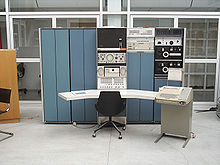- PDP-7
-
The DEC PDP-7 is a minicomputer produced by Digital Equipment Corporation. Introduced in 1965, it was the first to use their Flip-Chip technology. With a cost of only $72,000 USD, it was cheap but powerful by the standards of the time. The PDP-7 was the third of Digital's 18-bit machines, with essentially the same instruction set architecture as the PDP-4 and the PDP-9. It was the first wire-wrapped PDP.
In 1969, Ken Thompson wrote the first UNIX system in assembly language on a PDP-7, then named Unics as a pun on Multics, as the operating system for Space Travel, a game which required graphics to depict the motion of the planets. A PDP-7 was also the development system used during the development of MUMPS at MGH in Boston a few years earlier.
There are a few remaining PDP-7 systems still in operable condition, along with one under restoration in Oslo, Norway. The PDP-7 previously located at the University of Oregon in its Nuclear Physics laboratory is now at the Living Computer Museum in Seattle, Washington and is almost completely restored to running condition after being disassembled for transport. Another machine is known to be in the collection of Max Burnet near Sydney, Australia.
External links
- Raymond, Eric Steven (2003-09-19). "Origins and History of Unix, 1969–1995". faqs.org. http://www.faqs.org/docs/artu/ch02s01.html. Retrieved 2008-07-13.
- http://www.bell-labs.com/history/unix/pdp7.html "The famous PDP-7 comes to the rescue" (Bell Labs' Unix history).
- http://research.microsoft.com/~gbell/Digital/timeline/1964-3.htm PDP-7 entry from Year 1964 in the DIGITAL Computing Timeline.
- http://heim.ifi.uio.no/~toresbe/dec PDP-7 restoration project located in Oslo, Norway.
- http://dictionary.reference.com/browse/PDP-7 general information for the computer system.
- http://www.soemtron.org/pdp7.html information about the PDP-7 and PDP-7/A including some manuals and a customer list covering 99 of the possible 120 systems shipped.
- http://www.cs.uoregon.edu/Activities/talks/20110113-Lefevre.php University of Oregon's PDP-7 moves to the Living Computer Museum in Seattle, Washington.
Digital Equipment Corporation computers PDP VAX x86 MIPS Alpha This minicomputer-related article is a stub. You can help Wikipedia by expanding it.

